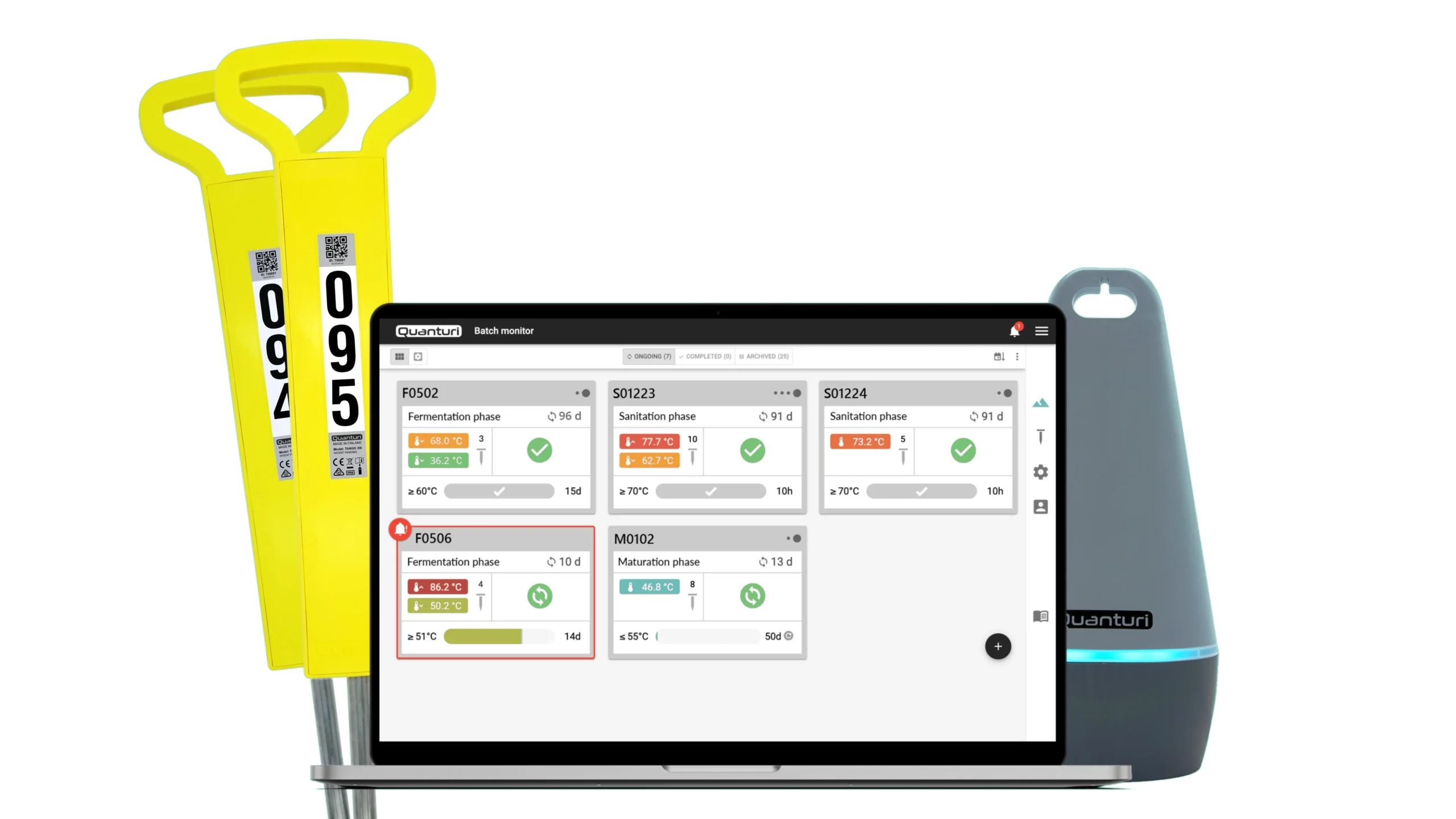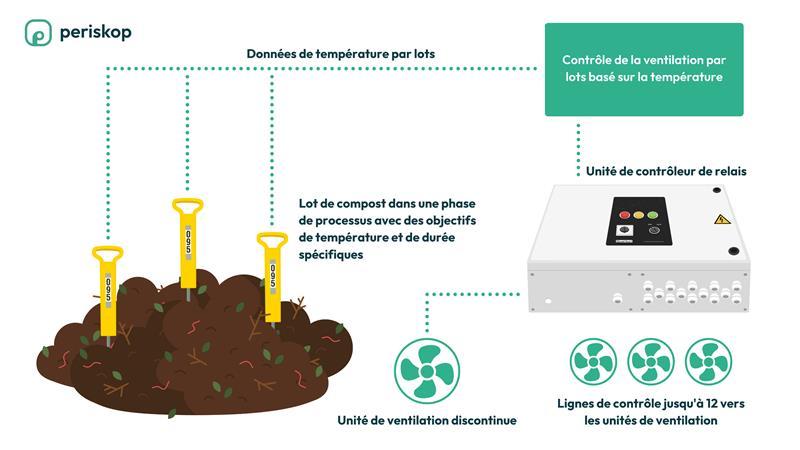The ultimate guide to aerated static pile (ASP) composting
Aerated Static Pile (ASP) composting is an efficient and eco-friendly method for managing organic waste. Using forced aeration, it accelerates decomposition while minimizing odors and conserving space, making it ideal for large-scale operations.
Aerated pile composting eliminates the need for frequent turning and ensures optimal oxygen and composting temperature in the pile. This guide explores the workings, benefits, and practical steps of ASP composting to help you reduce environmental impact and produce high-quality compost.
How does the aerated static pile composting work?
ASP composting is an aerobic process. The air supplied for oxygenation of the organic material in the pile speeds up the composting process. An aeration system uses fans with perforated pipes to push (positive pressure) or pull (Negative pressure) air throughout the compost pile. The air is used to maintain optimal levels of oxygen, moisture and temperature for the microbes. The pipes can be installed in channels, on top of the floor or included in the compost pile.
Why aerated static pile composting
In aerated static pile composting, biodegradation of organic matter happens fast due to constant supply of oxygen. Therefore, On a commercial scale, it has been considered the most effective, space-efficient and economical means of managing large quantities of organic waste.
It is an efficient way to minimize odors. Oxygen is supplied into the composting pile for the decomposition purposes. As a result, carbon dioxide and water is produced rather than the smelly ammonia and methane. It is not necessary to turn the aerated static pile as oxygen is supplied constantly for the decomposition. In addition, controlled airflow also helps to regulate the temperature for the optimal microbes activity.
History of aerated static pile (ASP) composting
There are two aeration methods in the static pile composting process. The negative aeration control also known as Beltsville’s Method was developed by the US Department of Agriculture’s Research Center in the 1970s. In this method simple timer control motors were used to pull air throughout the pile. Later, in the 1980s this method was modified with positive aeration by Dr. Melvin Finstein at Rutgers University, alongside a temperature feedback loop to maintain the pile temperature at a constant level.
Aerated static pile composting design
A well-designed ASP system ensures efficient airflow, temperature control, and compost quality. Key design elements include:
-
Pipe Configuration: Perforated pipes are laid either under the pile (in-floor) or embedded within layers of the compost. The layout depends on space, budget, and material type.
-
Aeration Method: ASP systems can use positive aeration, which pushes air, or negative aeration, which pulls air. These methods are often controlled by thermostats or timers.
-
Pile Dimensions: A typical pile is 4–6 feet high and 10–12 feet wide, allowing for adequate airflow and microbial activity.
-
Sensors & Controls: Temperature probes and oxygen sensors can be integrated with smart systems for real-time monitoring and automated fan control.
-
Covering: Using breathable covers helps maintain moisture and temperature while reducing odors and runoff
How to prepare the Ideal ASP composting recipe
All composting processes start with the balanced mixture of nutrients. A balanced nutrients recipe should have valid characterization data of total carbon, nitrogen, moisture content, free air space (FAS) and volatile solid materials in the pile.
A balanced recipe formula for ASP composting
- (C:N) ratio (>25:1)
- moisture content (50-55%)
- Free air space FAS) 40 and 60 percent
- 80 percent volatile solids
Volatile solids are extremely important to get a composting temperature in a pile. For instance, a compost pile consisting of woody materials will not not reach a desired composting temperature due to low volatile solids composition as compared to a pile consisting of food and paper scrap having high content of volatile solids. Free air space ensures a good pile environment for the biological life that supports decomposition of the materials in the pile.
Free air space in aerated composting pile
Free Air Space (FAS) is a way to measure how much empty space (air) is present in a pile of material, like hay or compost. This empty space is important because it allows air to flow through the pile. Free air space ensures a good pile environment for the biological life that supports decomposition of the materials in the pile. Good airflow helps with things like drying, preventing overheating, or maintaining the quality of the material.
There are two main ways air can move through the pile:
- Natural chimney effect: This happens when hot air naturally rises and pulls in fresh air from below.
- Fan effect: This happens when fans are used to push air through the pile. To figure out the FAS, we can use a formula based on how dense the pile is (its bulk density, which is how much material is packed into a given space, measured in kilograms per cubic meter):
FAS=100−(0.09 x Bulk Density (in kg/m3)
- Bulk Density: If the material is packed tightly (higher bulk density), there’s less free space for air, so FAS is lower.
- FAS: The result tells you what percentage of the pile is open space for air to flow.
For example: If the bulk density is 500 kg/m³, the formula gives: FAS=100−(0.09×500)=100−45=55%. This means 55% of the pile is empty space for air.
Aerated static pile composting process
1. Prepare area and feed stock
Prepare an area for receiving compost materials and for compost piles. Initially, place brown materials and food scrap in separate feedstocks. Keeping them separate will help you to mix those materials according to the standards and keep track of your feed stocks. It’s a good practice to cover the food scraps with cover or finished compost to counter animals and birds. It will also reduce the rotten food smell in a facility.
2. Mix food feedstock with brown
The recipe largely depends on the C:N ratios of browns and food scraps or greens. Remember to consider other parameters like moisture, PH oxygen. However, as rule of thumb usually the composter mixes 2x volume of brown materials to Volume of Food Scraps with an even mixture of bulkier wood chips and more easily digestible brown materials such as leaves or straw. You can follow The LSU AgCenter guidelines to have a good recipe of your compost pile:
How to calculate the proportions of raw materials for composting
3. Temperature Monitoring
Temperature is highly volatile in the static pile composting process. Regular temperature checks can be daunting and labour-intensive, and they also pose a risk to workers’ health due to the volatile materials in the pile. It is recommended to use Periskop wireless temperature monitoring system with mobile application that send alerts in case of abnormal situations. You can set different temperature thresholds based on the composting phase.
These systems enable you to regularly monitor the internal temperature of the compost pile using compost temperature probes and maintain a record of it. The standout feature of Periskop is its relay controller ventilation control unit, which helps manage ventilation in composting facilities. It integrates with a mobile application, allowing you to remotely control the ventilation. This system helps regulate oxygen supply and temperature. One can set automated rules to ensure that ventilation is only activated when needed, reducing energy costs and preventing extreme temperatures.
4. Compost curing stage
Now when you observe compost is no longer heating, put in the pile and continuously monitor the temperature and moisture. The curing process can last for several weeks or months. You can also perform compost quality tests on this stage.
5. Compost screening and finished product
The finished compost smells like soil and can be used in many ways. However, depending on its use you may need to screen it before. It can be used as soil amendment or mulch.


